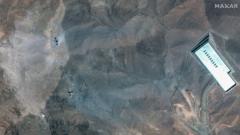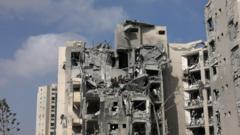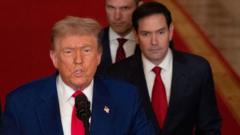**The article outlines the chaotic series of incidents that escalated the Israel-Iran conflict and the tenuous settlement that ensued.**
**Turbulent Hours Lead to Fragile Ceasefire in Middle East Conflict**

**Turbulent Hours Lead to Fragile Ceasefire in Middle East Conflict**
**A whirlwind of events within 24 hours has vacillated between attacks and negotiations, paving the way for a potential ceasefire in the Middle East.**
Over the past week since June 13, the Middle East has faced unprecedented tensions, including significant military assaults between Israel and Iran, culminating in a rapid succession of events that resulted in a fragile ceasefire.
The backdrop of escalating hostilities was characterized by Israeli strikes devastating crucial Iranian military assets, Iranian missiles breaching Israeli defense lines, and US operations targeting Iran’s nuclear capabilities. Tensions soared during a tumultuous 24 hours that began on Monday, featuring US airbase attacks, overt diplomatic attempts for a ceasefire, and the potential collapse of that deal.
As chaotic scenes unfolded, the day began with a cautious “shelter in place” advisory issued to US citizens in Qatar, indicating fears of retaliation from Iran, particularly against the al-Udeid military base, which plays a pivotal role in US air operations in the region. This warning, underscored by Tehran’s threats to seek revenge, loomed ominously over the tense atmosphere.
By midday, Doha announced a closure of airspace due to credible threats of an Iranian missile strike, leading to a chaotic rerouting of flights. Explosions soon followed as Iran’s state-run media confirmed retaliatory measures against American forces, painting US bases as “vulnerabilities.” Fortunately, the US and Qatari forces had anticipated the missile strike, which was reportedly intercepted, averting casualties.
Despite the Iranian offensive, leaders appeared to be looking for a way to de-escalate the situation. Within hours, US President Donald Trump took to social media, praising Iran for its “routine” response while also extending a peace overture: "It's time for peace," he remarked, urging all parties to come together.
Simultaneous behind-the-scenes negotiations intensified, with US officials engaged with both Iranian and Israeli representatives in a bid to halt hostilities. Trump’s call to Netanyahu highlighted a shift towards terms for a ceasefire amidst growing disturbances, culminating in an announcement of an agreement.
However, just as the ceasefire was declared, the conflict saw one last turbulent wave of missile exchanges. Israel reported incoming Iranian missiles targeting its territory, while retaliation also occurred, leading to casualties on both sides.
Despite assertions that both parties violated the ceasefire conditions shortly after inception, President Trump continued to advocate for peace. His stern words to both Netanyahu and Iranian leaders emphasized the potential consequences of further military action, highlighting the precarious balance and lingering uncertainty troubling the region. More questions than answers remain as the situation evolves into an uneasy tranquility.
The backdrop of escalating hostilities was characterized by Israeli strikes devastating crucial Iranian military assets, Iranian missiles breaching Israeli defense lines, and US operations targeting Iran’s nuclear capabilities. Tensions soared during a tumultuous 24 hours that began on Monday, featuring US airbase attacks, overt diplomatic attempts for a ceasefire, and the potential collapse of that deal.
As chaotic scenes unfolded, the day began with a cautious “shelter in place” advisory issued to US citizens in Qatar, indicating fears of retaliation from Iran, particularly against the al-Udeid military base, which plays a pivotal role in US air operations in the region. This warning, underscored by Tehran’s threats to seek revenge, loomed ominously over the tense atmosphere.
By midday, Doha announced a closure of airspace due to credible threats of an Iranian missile strike, leading to a chaotic rerouting of flights. Explosions soon followed as Iran’s state-run media confirmed retaliatory measures against American forces, painting US bases as “vulnerabilities.” Fortunately, the US and Qatari forces had anticipated the missile strike, which was reportedly intercepted, averting casualties.
Despite the Iranian offensive, leaders appeared to be looking for a way to de-escalate the situation. Within hours, US President Donald Trump took to social media, praising Iran for its “routine” response while also extending a peace overture: "It's time for peace," he remarked, urging all parties to come together.
Simultaneous behind-the-scenes negotiations intensified, with US officials engaged with both Iranian and Israeli representatives in a bid to halt hostilities. Trump’s call to Netanyahu highlighted a shift towards terms for a ceasefire amidst growing disturbances, culminating in an announcement of an agreement.
However, just as the ceasefire was declared, the conflict saw one last turbulent wave of missile exchanges. Israel reported incoming Iranian missiles targeting its territory, while retaliation also occurred, leading to casualties on both sides.
Despite assertions that both parties violated the ceasefire conditions shortly after inception, President Trump continued to advocate for peace. His stern words to both Netanyahu and Iranian leaders emphasized the potential consequences of further military action, highlighting the precarious balance and lingering uncertainty troubling the region. More questions than answers remain as the situation evolves into an uneasy tranquility.























